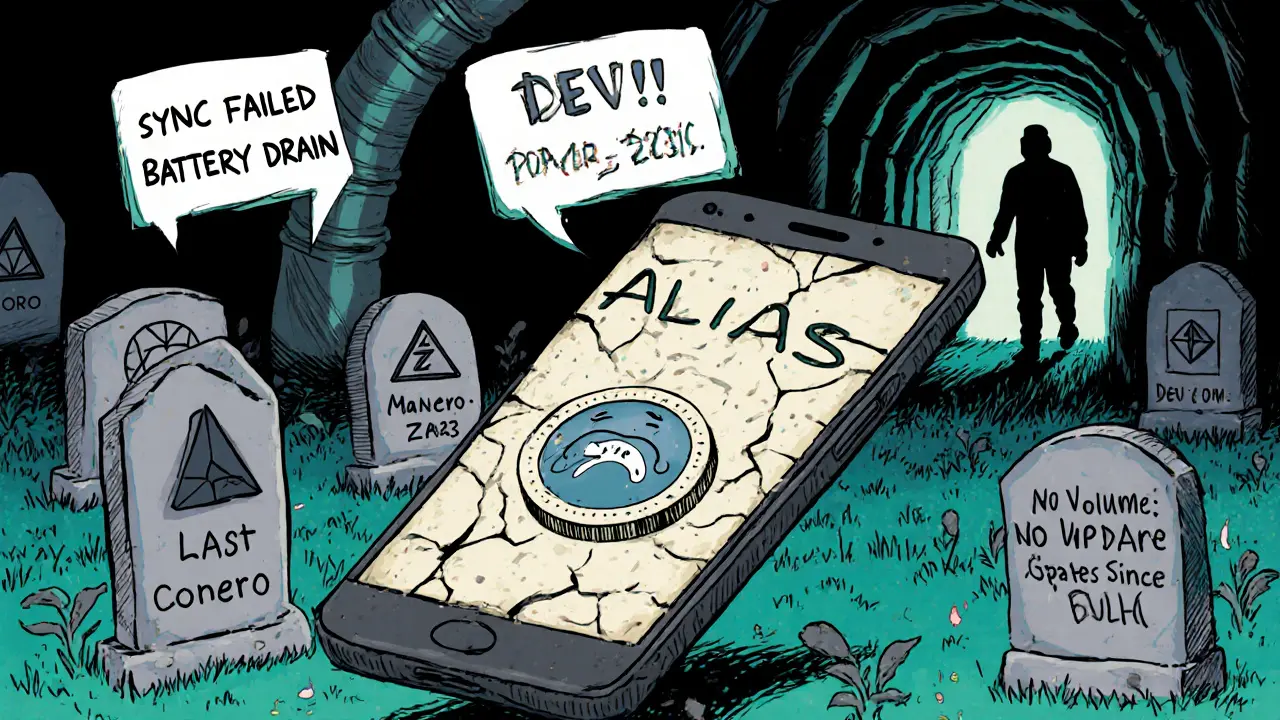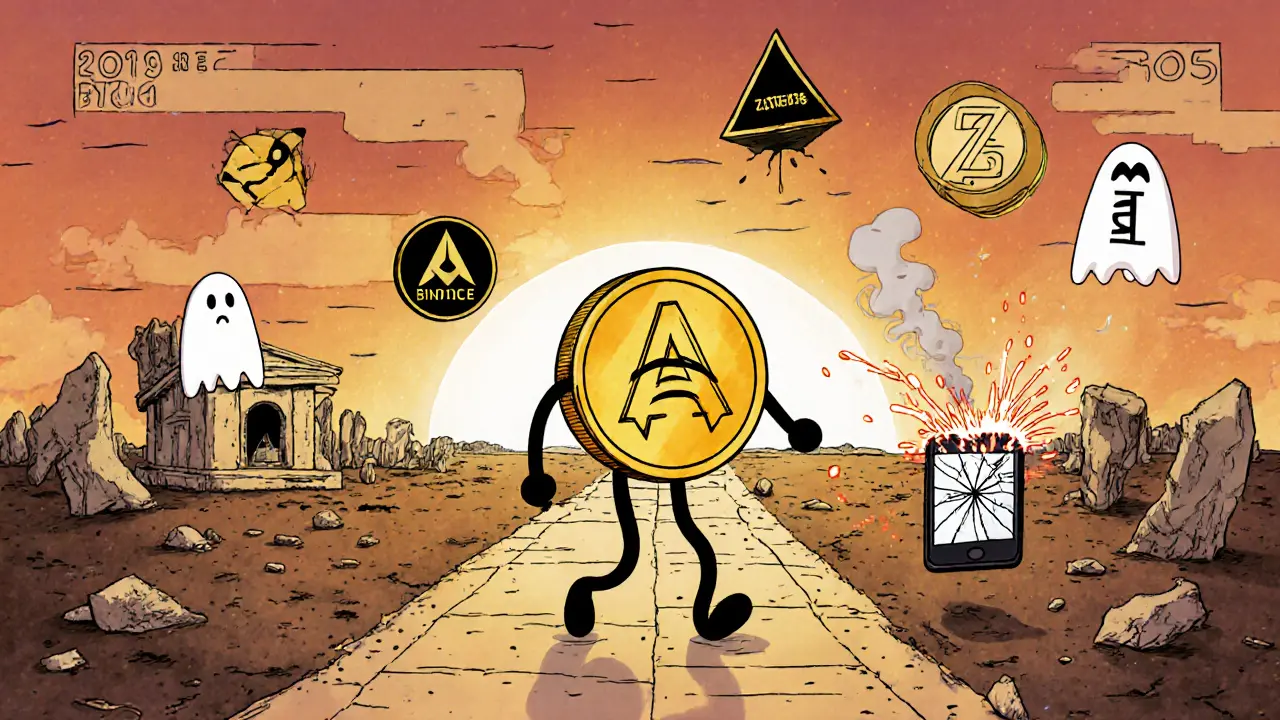ALIAS Price Loss Calculator
Calculate Your Potential Loss
Based on ALIAS's dramatic price decline from its all-time high of $6.74 to current trading range of $0.059-$0.084
ALIAS (ALIAS) is a cryptocurrency that claims to be private, anonymous, and energy-efficient. But if you’re looking to buy it, trade it, or use it for anything real - you’ll quickly find out it’s not just obscure. It’s barely alive.
What ALIAS actually does
ALIAS is built to hide your transactions. Unlike Bitcoin, where anyone can trace where your coins came from and where they went, ALIAS uses ring signatures to mix your transaction with others, making it nearly impossible to track the sender or receiver. It also adds Tor and OBFS4 to hide your IP address when you send or receive coins. That’s the same kind of privacy tech used by Monero - but ALIAS does it with less power. It runs on proof-of-stake, meaning you don’t need expensive mining rigs. You can even stake ALIAS from your Android phone without revealing your balance or identity. That’s called ‘Stealth Staking’ - a feature added in 2019 with the V3 hard fork.
On paper, it sounds like a solid privacy coin. But theory doesn’t pay bills. And ALIAS has been failing at the real-world test for years.
Price and market reality
As of November 21, 2025, ALIAS trades between $0.059 and $0.084 across different exchanges. That’s a far cry from its all-time high of $6.74 on January 2, 2018. Since then, it’s lost 98.85% of its value. Today, its market cap sits at $2.41 million. For comparison, Bitcoin’s market cap is over $1.2 trillion. Monero, another privacy coin, is worth over $2.8 billion. ALIAS is less than 0.001% of that.
Trading volume tells the real story. On CoinMarketCap, ALIAS moves just $1,035 in 24 hours. On Coinbase, it’s $389. On Liquidity Finder, it’s $289. That’s not trading - that’s a whisper. Most cryptocurrencies need at least 1-5% of their market cap in daily volume to be considered liquid. ALIAS is at 0.01%. That means if you try to buy $50 worth, you might get slapped with 15% slippage. One user on Bitget wrote: “Impossible to trade seriously.”
Where you can (and can’t) buy ALIAS
You won’t find ALIAS on Binance, Kraken, or Coinbase Pro. It’s only listed on six small exchanges, mostly obscure decentralized ones. That’s not just inconvenient - it’s dangerous. Low liquidity means wide bid-ask spreads, fake volume reports, and price manipulation. Some exchanges even claim ALIAS is “frequently traded,” but the numbers don’t lie. The trading volume hasn’t cracked $1,000 in months.
If you do find a place to buy it, you’ll need to use a wallet that supports ALIAS. The official Android wallet lets you stake coins on the go, but users report constant sync issues, battery drain, and crashes. There’s no iOS version. No desktop app with good support. And the official website, alias.cash, offers almost no tutorials, FAQs, or troubleshooting guides.

Development and community? Barely there
ALIAS hasn’t had a meaningful code update since March 2023. The GitHub repo has only three commits in the last year. That’s not maintenance - that’s abandonment. The team behind it hasn’t posted a real update in over two years. Their Twitter account, @ALIAS_Cash, has 2,147 followers. The last post? A generic market update on November 15, 2025. Two likes. Zero retweets.
The Telegram group has 187 members. Most are bots or inactive. Reddit has zero dedicated threads about ALIAS. Trustpilot has no reviews. GitHub issues from September 2025 are full of users stuck on wallet sync errors with no response from devs. This isn’t a crypto project with a community. It’s a ghost town with a blockchain.
Why ALIAS failed
It’s not that the tech is bad. Ring signatures + Tor + stealth staking? That’s actually advanced. The problem is execution - or lack thereof.
- It never built a user base.
- It never got listed on major exchanges.
- It never partnered with any merchants or services.
- It never responded to user feedback.
- It never updated its roadmap or whitepaper after 2020.
Privacy coins like Monero and Zcash survived because they had strong teams, active development, and real adoption. ALIAS had none of that. It launched with hype, then vanished. Today, it’s what experts call a “zombie coin” - technically running, but with no users, no traders, and no future.

Should you invest in ALIAS?
If you’re looking for a long-term investment? No.
If you’re looking to use it for payments? No.
If you’re looking to stake it for passive income? Only if you’re okay with losing access to your coins because the wallet crashes.
There’s no institutional interest. No ETFs. No futures. No custody solutions. No analyst coverage. Even the most speculative crypto traders avoid it. Messari’s Q4 2025 report says assets under $5 million market cap with under $10,000 daily volume have a 99.2% failure rate over five years. ALIAS is below both thresholds.
It’s not a scam. The blockchain works. The code is open. But it’s a project that stopped growing five years ago. And in crypto, standing still means dying.
What’s next for ALIAS?
Nothing, likely.
There are no announced upgrades, no partnerships, no marketing pushes. The official roadmap still says “privacy, security, decentralization” - but those words haven’t translated into action since 2019. The project is in maintenance mode, if that. Even the data across exchanges doesn’t agree. CoinMarketCap says 31.13 million ALIAS are in circulation. Bitget says 30.76 million. Liquidity Finder says 31 million exist… but zero are circulating. That’s not a data glitch - that’s a project that’s lost control of its own narrative.
ALIAS is a relic. A curiosity. A cautionary tale.
It proves that even the best privacy tech means nothing if no one uses it, no one supports it, and no one believes in it anymore.
Is ALIAS a good investment?
No. ALIAS has lost over 98% of its value since its peak in 2018. It trades with less than $1,000 in volume daily, has no exchange listings beyond six obscure platforms, and shows zero development activity. It’s classified as a “zombie coin” by analysts - technically alive but with no future. Investing in ALIAS is speculative at best and likely a loss at worst.
Can I stake ALIAS on my phone?
Yes, the official Android wallet supports mobile staking with stealth staking (PoAS) enabled. This lets you earn rewards without revealing your balance or identity. But users report frequent sync failures, crashes, and high battery drain. There’s no iOS version, and the app hasn’t been updated since 2022. Use at your own risk.
Where can I buy ALIAS?
ALIAS is only available on six small exchanges, including Binance (limited pairs), Coinbase (6 markets), and Liquidity Finder. It’s not on major platforms like Kraken, Coinbase Pro, or Bitstamp. Trading is extremely difficult due to low liquidity - slippage often exceeds 15% on small trades. Always use a trusted wallet and never send ALIAS to an address you don’t control.
Is ALIAS truly anonymous?
Technically, yes. ALIAS uses ring signatures to hide transaction origins and Tor+OBFS4 to mask your IP address. These are the same tools used by Monero. But anonymity only matters if people are using it. With almost no transactions happening, there’s no real privacy network to blend into. Your transaction could be the only one on the chain that day - making it easier to track by default.
Why is ALIAS so cheap now?
ALIAS peaked in 2018 during a crypto hype cycle, then faded as developers stopped working on it and users moved to better privacy coins like Monero and Zcash. With no updates, no community, and no exchange support, demand collapsed. The price drop isn’t just market noise - it’s a result of total abandonment. The coin survives only because the blockchain still runs, not because anyone wants to use it.
Does ALIAS have a future?
Unlikely. With less than $2.5 million in market cap, under $1,000 in daily volume, and zero development activity for over two years, ALIAS has no path to recovery. It lacks the team, funding, community, or exchange support needed to revive it. Even if privacy becomes more popular, ALIAS is too far behind to catch up. It’s a historical footnote, not a future asset.

Comments (11)
sky 168
November 23, 2025 AT 13:18
ALIAS isn't dead, it's just waiting for someone with vision to pick it up. The tech is solid, the privacy features are legit. It's the community and marketing that failed, not the code.
Lynn S
November 24, 2025 AT 03:16
Let me be clear: this isn't a 'zombie coin.' It's a corpse with a blockchain attached. Anyone still holding ALIAS is either delusional or emotionally attached to a project that stopped existing in 2020. The wallet crashes. The devs are silent. The volume is less than your coffee run. This isn't investing. It's digital hoarding.
jack leon
November 24, 2025 AT 23:53
ALIAS was supposed to be the quiet assassin of crypto - stealthy, private, unstoppable. Instead, it became the ghost haunting the back alleys of decentralized exchanges. No updates. No energy. No heartbeat. It’s like finding a Ferrari in a junkyard and realizing the engine was pulled out years ago. The chassis still looks pretty… until you try to start it.
Chris G
November 26, 2025 AT 00:45
Ring signatures + Tor = good. No devs + no volume = bad. Simple math. Stop romanticizing dead coins. If it’s not on Binance or Coinbase, it’s not real money. It’s a digital art project with a ticker symbol.
Devon Bishop
November 27, 2025 AT 22:05
Im gonna be real - i tried staking ALIAS on my phone last year. Wallet crashed 3 times in 2 days. Battery drained like it was on fire. I lost 0.3 ALIAS because i sent it to the wrong address and the dev team never replied to my github issue. I dont blame the tech. I blame the total lack of support. You cant build trust when your team is MIA.
Khalil Nooh
November 28, 2025 AT 05:43
Listen. This isn't about money. This is about legacy. ALIAS had the potential to be the privacy coin for the everyday person - no mining rigs, no complexity, just stealth staking on your phone. But instead of building, they vanished. And now? We’re left with a blockchain that runs perfectly… for no one. That’s not failure. That’s tragedy.
sammy su
November 28, 2025 AT 09:18
im not saying buy it but if you got a few bucks to throw at a ghost story, why not? the blockchain still works. the wallet still runs (kinda). and if one day someone wakes up and decides to fix it? you could be holding the next monero. or you could just lose $20. either way, its a story worth telling.
Melina Lane
November 29, 2025 AT 06:36
My grandma asked me if ALIAS was safe to buy. I showed her the volume charts. She said, 'honey, that’s not an investment, that’s a museum piece.' And honestly? She’s right.
andrew casey
November 30, 2025 AT 11:26
One must wonder whether the ALIAS project was ever truly a cryptocurrency - or merely a performative artifact of the 2017–2018 speculative fever, now preserved in the amber of blockchain archaeology. Its technical architecture, while theoretically elegant, has been rendered functionally obsolete by the absence of human will. To speak of its 'potential' is to engage in necromancy.
Natalie Reichstein
December 1, 2025 AT 20:42
People still holding ALIAS are either naive or complicit. You knew the devs disappeared. You saw the volume drop. You ignored the GitHub silence. You chose to believe in a ghost because you didn’t want to admit you made a mistake. That’s not investing. That’s self-deception dressed up as hope.
Jack Richter
December 2, 2025 AT 04:19
meh